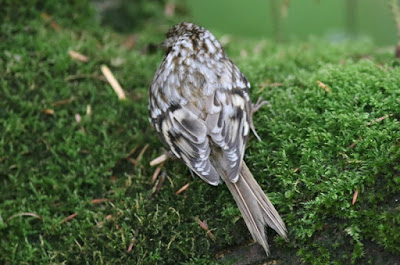 |
| Northern Treecreeper Vidlin, Shetland 22nd October 2017 |
1. How this bird was pecking away low down, on moss clad trees, and moving fairly rapidly within a small area. It was the most showy treecreeper I'd ever seen!
2. It was mega cold in appearance, more so than the photos suggest. It did give a bit of a Black-and-White Warbler feel... honestly.
Most of us will be aware of Northern Treecreepers, potentially from commentary from the late Martin Garner on his Flamborough bird here and here and also in his Birding Frontiers Challenge Series: Autumn. Anyway, Northern Treecreeper refers to the nominate race familiaris, with the warmer toned British birds being aptly named the britannica subspecies. Nominate birds are apparently clinal, with the further east you go the colder and greyer they become - so the BBRC says. And why are the BBRC interested? Because it is a description species, although there is a bit of conflicting info in terms of its actual status: -
- 'Nominate familiaris is also on the British List but its published status in the literature is somewhat contradictory. Witherby et al. (1940) listed only four records but it is described in the BOU 8th Checklist and in Kehoe (2006) as a scarce migrant. Cramp et al. (1993) described it as a rare vagrant in Britain and also noted its rarity in the Netherlands and on Heligoland, Germany. It appears to be a genuinely rare late autumn (and sometimes wintering) vagrant, occurring as part of occasional irruptions out of Scandinavia and with very few confirmed records from east coast migration ‘hotspots’. Only on Shetland are more occurrences documented but even here it is rare.' BBRC website.- '39 records in Shetland up to 2004, where British birds assumed not to occur. 78 Lanceolated Warblers and 128 Subalpine Warblers in the same period in Shetland. Exceptionally, two were trapped at Spurn in autumn 2013 but otherwise 3 previous confirmed records of Northern Treecreeper. In Norfolk there are 3 records indicted with one trapped bird with biometrics outside of the range for brittanica. On the Farne Islands (Northumberland) one accepted record on 20th October 2004 out of 22 records of Treecreeper in total per David Steele. Conclusion: It's a rare bird.' Birding Frontiers.
So despite a little contradiction in its status, what should we be looking out for? Note that much of this comes from previous Birding Frontiers pointers: -
- a white supercilium that flares and broadens behind the eye
- underparts cold white with any colour confined to rear flanks; vent and undertail-coverts are wholly white too
- mantle and scapulars greyish in overall tone, with white centres giving a spotted, cold effect
- pale secondary panel lacking any warmth
 |
| Northern Treecreeper Vidlin, Shetland 22nd October 2017 |
Anyway, I really enjoyed this bird and thought it was worth highlighting these northern birds once again.






















